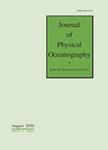版权所有:内蒙古大学图书馆 技术提供:维普资讯• 智图
内蒙古自治区呼和浩特市赛罕区大学西街235号 邮编: 010021

作者机构:Korea Inst Ocean Sci & Technol 787 Haeanro Ansan 426744 South Korea Geo Syst Res Corp Gunpo South Korea Kyungpook Natl Univ Kyungpook Inst Oceanog Taegu 702701 South Korea Inha Univ Inchon South Korea
出 版 物:《JOURNAL OF PHYSICAL OCEANOGRAPHY》 (物理海洋学杂志)
年 卷 期:2016年第46卷第3期
页 面:937-946页
核心收录:
基 金:KIOST Research programs [PE99396, PE99392] Korea Institute of Science and Technology Information (KISTI) National Research Foundation of Korea grant - South Korean government [NRF-2009-C1AAA001-0093065]
主 题:Observational techniques and algorithms Ocean dynamics Trajectories Circulation/ Dynamics Profilers, oceanic Seasonal variability Ocean circulation Variability Wind stress
摘 要:Trajectories of Argo floats deployed in the East/Japan Sea from 2001 to 2014 reveal that the middepth gyral circulation pattern of the Japan basin, the central part of the East/Japan Sea, undergoes a seasonal variation. The middepth circulation of the Japan basin is found to be characterized usually by the gyres trapped to the east of the Bogorov Rise (E-gyres) and those extending farther westward into the whole basin (BW-gyres). The E-gyre trajectories are generally associated with the turning of the floats toward deeper regions off the isobaths. This occurs in winter either on the northern or eastern side of the eastern Japan basin. It seems that the upstream part of the otherwise BW-gyre is subject to a strong negative wind stress curl in winter, and there the circulating water columns are driven toward the deeper region, thus triggering the formation of the E-gyre. The topographic effect associated with the Bogorov Rise seems to interfere thereafter in the process of determining the passage of the E-gyre. Otherwise, the water columns continue to flow along the isobaths, hence maintaining the BW-gyre. To the knowledge of the authors, this is the first observational evidence of seasonal variability in the middepth gyral circulation pattern in the East/Japan Sea. It suggests that oceanic middepth circulation, usually known to be quasi steady or slowly varying on climatological time scales, might also undergo a significant seasonal variation as it does in the East/Japan Sea.